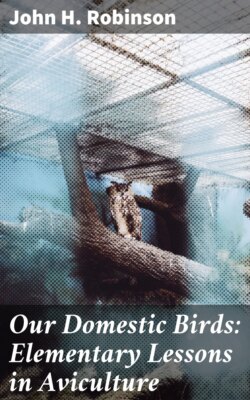Читать книгу Our Domestic Birds: Elementary Lessons in Aviculture - John H. Robinson - Страница 6
На сайте Литреса книга снята с продажи.
Оглавление[1] Photographs (Figs. 4-8) from Bureau of Animal Industry, United States Department of Agriculture.
Fig. 9. Chick ready to break shell
Development of the embryo in a bird's egg. The condition required to produce a live bird from a fertile egg is the continuous application of a temperature of about 102 or 103 degrees Fahrenheit from the time the heat is first applied until the embryo is fully developed and ready to emerge from the shell. In nature the heat is applied by contact with the bodies of the parent birds. Development of life will start in an egg at about 10 degrees below the temperature required to maintain it, but at this temperature the germ soon dies. The temperature in incubation may occasionally go higher than 103 degrees or may be as low as 70 degrees for a short time without injury to the germ. Some germs will stand greater extremes of temperature than others, just as some living creatures will.
The first stages of the development of life in the egg of a bird may be observed by holding the eggs before a strong light in a darkened room. White-shelled eggs are the best for this purpose. In about thirty-six hours from the beginning of incubation it will be found that the germ has turned red, and little red veins radiate from it somewhat like the legs of a spider. For several days the egg is quite translucent and the yolk shows plainly. As the germ grows, the contents of the egg become clouded and dense, and the air space at the large end of the egg is clearly defined, the density being greatest near it. From the time that the egg becomes dense, observations of development must be made by breaking one or more eggs daily or every few days, according to the number available for observation.
Fig. 10. Egg before exclusion and partially excluded chick
Fig. 11. Light Brahma (day old)
The embryo grows until it fills the egg. The mere application of heat to the egg has gradually transformed that little germ and the yellow and white of egg into bones, flesh, skin (and, in some cases, down), and all the organs of a living creature. When the embryo has filled the shell, it lies curled up, usually with the head at the large end of the egg and the beak almost touching the shell, at about one third of the distance from the large to the small end of the egg. At the point of the beak of the young bird on the curved tip of the upper mandible is a small horny scale. Without this scale it would be hard for the embryo to break the shell because it cannot, as it lies, strike it a direct blow with the point of its beak. This scale is a remarkable character. Its only use is to help the bird out of the shell. A few days after exclusion it disappears.
If you take a hen's egg about the eighteenth or the nineteenth day of incubation and hold it closely in your hand, you may be able to feel the chick move. If your hand is a little bit cold, the chick is much more likely to squirm in the egg and may utter a peep. If, with the egg in a warm hand, you hold it to your ear, you will about this time hear an occasional tap, tap, caused by the chicken striking its beak against the shell. The tapping is kept up more or less steadily until the shell cracks where the point of the beak strikes it and a little piece is broken out. The chick usually rests awhile now,—perhaps for some hours,—then resumes the attack on the shell. It turns in the shell, breaking out little pieces as it turns, until there is a crack nearly all the way around, when, by pushing with its head and feet, it forces the shell apart and sprawls out of it.
The process is the same for all birds, except that those that take longest to develop in the shell take a longer rest after first breaking it. The young of aërial birds, which are naked when hatched, are ugly little things. Young poultry, too, are almost repulsive with their sprawling forms and the wet down plastered to the skin, but in a few hours they grow strong, the down dries and becomes fluffy, the bright little eyes seem to take in everything, and they are the most attractive of all baby animals.
